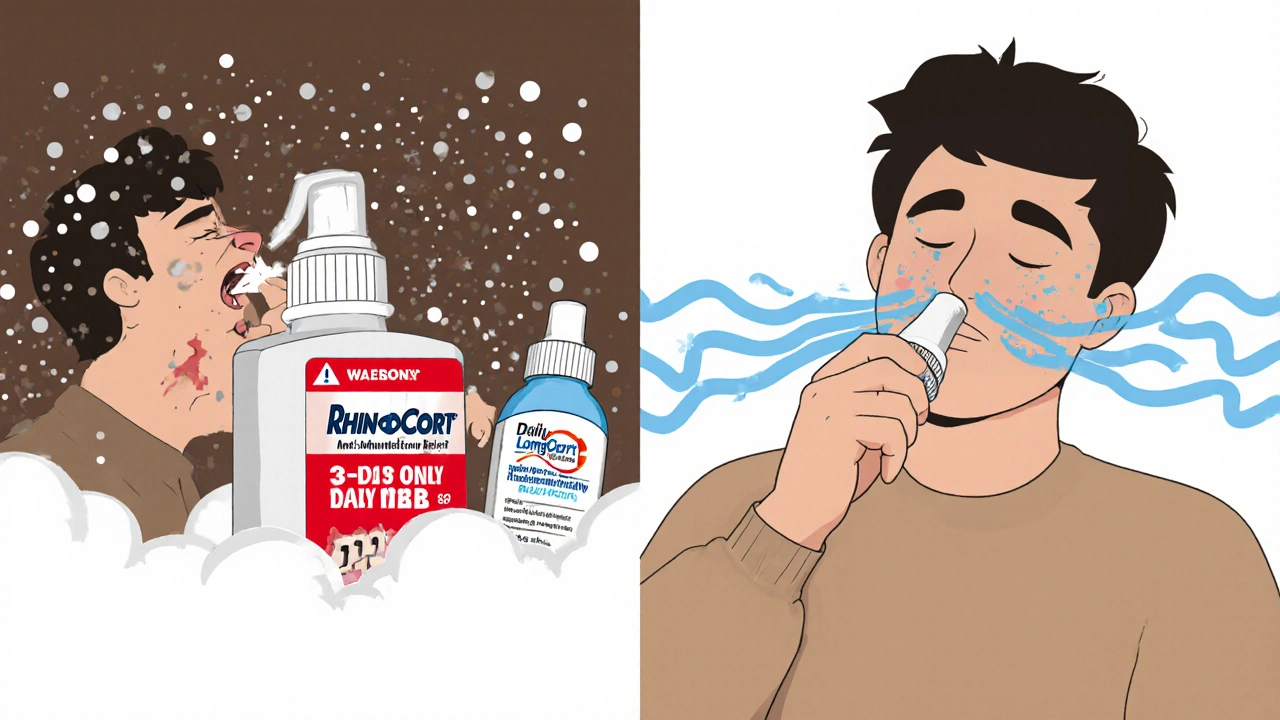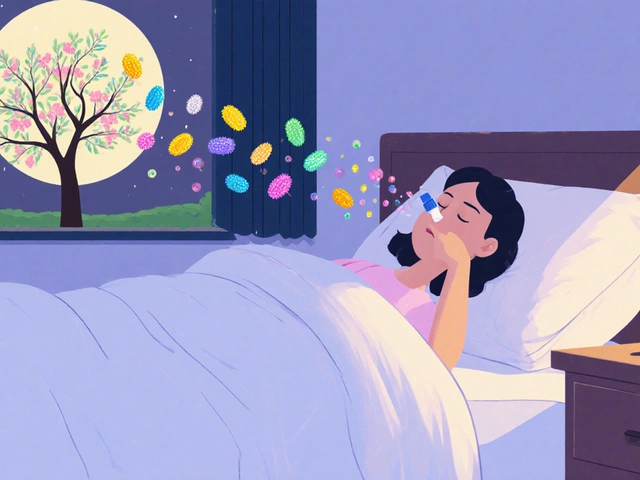Rhinocort is a nasal spray used to treat allergic rhinitis - the sneezing, runny nose, and itchy eyes you get when pollen, dust, or pet dander trigger your immune system. Unlike oral antihistamines that make you drowsy, Rhinocort works right where the problem starts: inside your nose. It’s not a quick fix like decongestant sprays, but if you use it daily during allergy season, it can cut symptoms by half or more. Many people don’t realize it’s a corticosteroid, and that scares them. But this isn’t the same as the steroids athletes abuse. Rhinocort delivers a tiny, targeted dose directly to your nasal lining, with almost no effect on the rest of your body.
How Rhinocort Actually Works
Rhinocort contains budesonide, a synthetic corticosteroid. When you spray it into your nose, it sinks into the lining of your nasal passages. There, it stops immune cells from releasing histamine and other chemicals that cause swelling, mucus, and itching. Think of it like turning down the volume on your body’s allergic alarm system. It doesn’t kill allergens - it just makes your nose less reactive to them.
Because it works on inflammation, not just symptoms, you won’t feel relief right away. Most people start noticing a difference after 3 to 5 days. Full effect usually takes 1 to 2 weeks of daily use. That’s why people stop using it too soon - they think it’s not working. But if you skip doses, the inflammation comes back. Consistency matters more than the dose size.
Who Should Use Rhinocort
Rhinocort is approved for adults and children aged 6 and older. It’s most effective for people with persistent allergic rhinitis - meaning symptoms last more than 4 days a week or for more than 4 weeks at a time. If you get sneezing fits every spring when the trees bloom, or your nose runs all winter because of dust mites in your bedding, Rhinocort is a good fit.
It’s also used for non-allergic rhinitis, like vasomotor rhinitis, where triggers are things like cold air, strong smells, or changes in humidity. If you’ve tried antihistamines and decongestants and they either didn’t help or gave you a dry mouth and jittery feeling, Rhinocort might be a better option.
It’s not for sudden, severe congestion from a cold or sinus infection. Those need different treatment. And if you’ve had recent nasal surgery, nose ulcers, or untreated fungal infections, talk to your doctor first.
Dosing and How to Use It Right
The standard dose for adults and kids 12+ is two sprays in each nostril once a day. For kids 6 to 11, it’s one spray in each nostril daily. Some doctors may start with two sprays per nostril for the first week, then drop to one if symptoms improve - but always follow your prescription.
Here’s how to use it correctly:
- Shake the bottle gently before each use.
- Blow your nose to clear out mucus.
- Tilt your head slightly forward - don’t lean back.
- Insert the nozzle into one nostril, close the other with your finger.
- Press the pump while breathing in gently through your nose.
- Hold your breath for a second, then breathe out through your mouth.
- Repeat for the other nostril.
Don’t sniff hard - that sends the spray to your throat, where it can taste bitter and cause irritation. Don’t aim the spray toward the center of your nose (the septum). Point it slightly outward, toward your ear. This avoids damage and helps the medicine spread evenly.
Wipe the nozzle with a clean tissue after each use. Don’t rinse it with water - that can damage the pump. Replace the cap tightly.
Side Effects and What to Watch For
Most people tolerate Rhinocort well. The most common side effects are mild and local: dryness or irritation in the nose, a slight burning sensation, or an unpleasant taste. These usually fade after a few days.
Less common but worth noting:
- Nosebleeds - especially if you’re spraying too hard or have dry nasal passages. Using a saline spray before Rhinocort can help.
- Headaches - rare, but possible.
- Throat irritation or cough - usually from swallowing some of the spray.
Very rarely, long-term use can lead to fungal infections in the mouth or throat (oral thrush). Rinsing your mouth with water after spraying (without swallowing) reduces this risk. Children on long-term treatment may have slightly slower growth, but studies show the effect is small and usually catches up after stopping.
Signs you need to stop and call your doctor: persistent nosebleeds, white patches in your mouth, vision changes, or worsening symptoms after 2 weeks of use.

Rhinocort vs. Other Nasal Sprays
There are many nasal sprays on the market. Here’s how Rhinocort stacks up:
| Brand | Active Ingredient | Onset of Action | Frequency | Best For |
|---|---|---|---|---|
| Rhinocort | Budesonide | 3-7 days | Once daily | Persistent allergies, inflammation control |
| Flonase | Fluticasone | 2-4 days | Once daily | Similar to Rhinocort, slightly stronger |
| Nasonex | Mometasone | 2-3 days | Once daily | Children, sinus pressure |
| Afrin | Oxymetazoline | Minutes | Up to 3 days only | Short-term congestion, not allergies |
| Claritin-D | Loratadine + Pseudoephedrine | 1-3 hours | Once daily | Oral option with decongestant |
Rhinocort is not the strongest corticosteroid spray, but it’s one of the most balanced - effective without excessive side effects. Flonase and Nasonex are similar, but some people find Rhinocort less irritating. Afrin gives instant relief but can cause rebound congestion if used longer than 3 days. Oral antihistamines like Claritin-D help with sneezing and itching but do little for nasal blockage.
What to Avoid
Don’t combine Rhinocort with other nasal corticosteroids - you won’t get extra benefit, and you increase side effect risk. Don’t use it if you’ve had a recent nose injury or surgery unless your doctor says it’s safe. If you’re pregnant or breastfeeding, talk to your doctor. While studies show budesonide is low risk, it’s still a steroid.
Also avoid using it if you have untreated tuberculosis, fungal infections, or severe liver disease. It’s not a drug you should self-prescribe for long-term use without medical supervision.
When to Switch or Add Something
If you’ve used Rhinocort daily for 4 weeks and still have symptoms, it’s time to reassess. Maybe your triggers aren’t what you think - maybe you’re reacting to mold, not pollen. Or maybe you need to combine it with an antihistamine like cetirizine for itch and sneezing.
Some people benefit from saline rinses (neti pots) in the morning, then Rhinocort at night. This clears out allergens and lets the spray work better. Others add eye drops for itchy eyes. Rhinocort doesn’t help with eye symptoms.
If you’re still struggling after 6 weeks, your doctor might suggest allergy testing or immunotherapy - shots or tablets that slowly train your immune system to ignore allergens. That’s a longer-term solution, but it can change how you live with allergies forever.

Where to Get It
Rhinocort is available by prescription in the UK and many other countries. In the US, it’s also sold over the counter as Rhinocort Aqua. The active ingredient is the same, but the delivery system and dosage may vary slightly. Always check the label. Generic budesonide nasal spray is often cheaper and just as effective.
Pharmacies in Manchester, London, or anywhere else will stock it. If cost is an issue, ask your GP about generic alternatives. Most NHS prescriptions are free for those eligible, and private prescriptions usually cost under £10.
Real-Life Use Case
Emma, 34, from Salford, used to dread April. Her nose ran constantly, she couldn’t sleep, and she missed two days of work last year. She tried antihistamines - they made her groggy. She used decongestant sprays - they helped for a few days, then made her worse. Her GP prescribed Rhinocort. She used it every night, even when she felt fine. After 10 days, her congestion cleared. After 3 weeks, she could breathe through her nose while sleeping. She didn’t stop using it until June. Now, she starts Rhinocort the first week of March, every year. She hasn’t missed work since.
Can I use Rhinocort every day for years?
Yes, many people use Rhinocort daily for years without serious issues. Long-term studies show it’s safe for adults and children when used as directed. The dose is low and local, so it doesn’t affect your hormones or bones like oral steroids might. Still, see your doctor once a year to check for side effects like nasal thinning or growth delays in children.
Does Rhinocort cause weight gain?
No, Rhinocort does not cause weight gain. The amount of steroid absorbed into your bloodstream is extremely small - less than 5% of the spray. That’s far below the level needed to affect metabolism or fat storage. Weight gain is a side effect of oral or injected steroids, not nasal sprays like Rhinocort.
Is Rhinocort better than Flonase?
They’re very similar. Both are corticosteroid nasal sprays with nearly equal effectiveness. Rhinocort (budesonide) is slightly less likely to cause nosebleeds in some users. Flonase (fluticasone) may work a bit faster for some. The best one is the one you’ll use consistently. If one irritates your nose, try the other.
Can children use Rhinocort?
Yes, Rhinocort is approved for children aged 6 and older. The dose is lower - one spray per nostril daily. Studies show it’s safe and effective. Growth suppression is a rare concern, but the effect is minimal and reversible. Always use the lowest effective dose and monitor height annually if used long-term.
What happens if I stop using Rhinocort suddenly?
Your allergy symptoms will likely return within a few days. Unlike some steroids, Rhinocort doesn’t cause withdrawal. You won’t feel sick or get rebound congestion. But your nose will go back to being sensitive to allergens. If you want to stop, it’s fine - just expect symptoms to come back. Some people use it seasonally and stop in the fall, then restart in spring.
Can I use Rhinocort with other allergy meds?
Yes. Rhinocort works well with oral antihistamines (like loratadine or cetirizine), eye drops for itchy eyes, and saline rinses. Many people combine them for full symptom control. Just avoid other steroid nasal sprays - you don’t need two. Always check with your pharmacist if you’re unsure about interactions.
Final Thoughts
Rhinocort isn’t magic. It won’t cure your allergies. But for millions of people, it’s the difference between living with symptoms and living normally. It’s not the loudest option on the shelf, but it’s one of the most reliable. If you’ve been stuck with a runny nose, itchy eyes, and poor sleep - and nothing else worked - Rhinocort might be what you’ve been missing. Use it right. Be patient. And give it a real chance before giving up.


benedict nwokedi
November 19, 2025 AT 06:52Let me guess-this is just Big Pharma’s latest brainwash tactic to make you dependent on steroids under the guise of ‘safe’ nasal sprays. They’ve been quietly replacing your nasal microbiome with synthetic cortisol for decades, and now they’re marketing it as ‘non-systemic’ like that’s some kind of moral victory. You think your nose is a sacred temple? It’s a battleground-and they’re weaponizing your ignorance with fancy jargon. Budesonide? Sounds like a secret CIA code. I’ve seen the studies they don’t want you to see…
deepak kumar
November 21, 2025 AT 04:55Actually, this is one of the best explanations I’ve read on nasal steroids. I’ve been using Rhinocort for 3 years now, and it’s been life-changing. I used to sneeze non-stop during monsoon season-now I just spray once and sleep like a baby. The key is consistency. Don’t stop after 3 days like some people do. And yes, it’s a steroid, but it’s like using a tiny drop of paint on a mural-not the whole can. Trust the science, not the fear.
Also, if you’re Indian, try using a saline rinse before spraying. Works wonders with our dusty air. 🙏
Dave Pritchard
November 23, 2025 AT 00:09Hey, I just want to say thank you for writing this in such a clear way. I’ve been avoiding nasal sprays because I thought they’d mess with my hormones or make me gain weight-like the old-school steroid stigma. But this broke it down so simply. I started Rhinocort last spring and didn’t even realize how much I was breathing through my mouth until I could finally breathe through my nose again. I’m not a ‘medical person,’ but this made me feel confident. If you’re on the fence-just give it 2 weeks. No magic, just math.
Also, don’t aim at the septum. I did that once. Ouch.
kim pu
November 23, 2025 AT 04:23Okay but have you ever noticed how the FDA lets these ‘low-dose’ steroids fly while banning real natural remedies like quercetin or butterbur? Coincidence? I think not. They’re selling you a $70/month spray because they can’t patent a turmeric root. And don’t even get me started on the ‘non-systemic’ lie-your lymphatic system isn’t fooled. I’ve had chronic fatigue since I started using it. Not saying it’s the spray, but… the timing? Suspicious. 🤔
malik recoba
November 24, 2025 AT 19:14i just wanted to say this post helped me a lot. i was scared to use it cause i thought it was like the stuff bodybuilders take. but now i get it-it’s just a little spray in the nose. no big deal. i started last week and my nose isn’t running all day anymore. i still forget to shake it sometimes, oops. but yeah, thanks for writing this. really.
p.s. i used to think i was just ‘allergic to life’ but turns out it was pollen. lol
Sarbjit Singh
November 25, 2025 AT 18:09Bro, this is gold! 😊 I’ve been using Rhinocort since 2020 and it’s my MVP. My kids (7 & 9) use it too-1 spray each, every night. No more midnight sneezing fits. And yeah, the taste? Weird at first. But you get used to it. Just don’t spray while looking up-learned that the hard way. 😅
Pro tip: Keep it in the fridge. Feels nice and helps with swelling. Good stuff!
Angela J
November 26, 2025 AT 20:43Wait… so you’re telling me this ‘safe’ steroid doesn’t affect my adrenals? But what about the 2018 WHO internal memo leaked on Reddit that said all nasal corticosteroids are stealth hormone disruptors? I’ve been reading forums for months-people are losing their sleep cycles, their moods, their *souls*… and no one talks about it. I’m not paranoid-I’m *informed*. I’ve switched to Himalayan salt nasal rinse and I feel… freer. 🕊️
Sameer Tawde
November 27, 2025 AT 23:16Consistency beats intensity. That’s the rule with Rhinocort. Don’t wait for symptoms to be bad-start early. March 1st, not April 15th. And if you miss a day? Don’t double up. Just go back to normal. Your nose doesn’t need a lecture, just routine.
Also, saline rinse + Rhinocort = combo of the century. Works like a charm. You got this.
Erica Lundy
November 29, 2025 AT 13:25The philosophical underpinning of this intervention-topical corticosteroid suppression of mucosal immune reactivity-raises intriguing questions about the ontological boundaries of selfhood in the context of chronic allergic pathology. If the body’s inflammatory response is, in essence, a misinterpretation of benign environmental stimuli, then Rhinocort does not merely alleviate symptoms; it enforces a negotiated truce between organism and environment, wherein the immune system is coerced into epistemic humility. One must ask: Is the reduction of histamine release an act of healing, or a form of biological pacification? And if so, what is the cost of such quieted rebellion?
That said, the empirical data supporting its safety profile remains compelling. One might consider it a quiet, almost poetic, solution: a micro-dose of synthetic order imposed upon the chaos of allergic chaos, administered with the ritual of a daily breath.